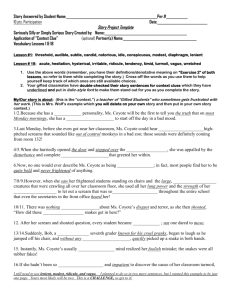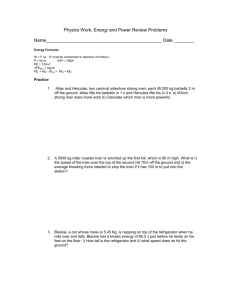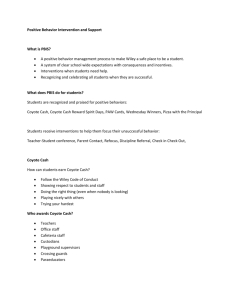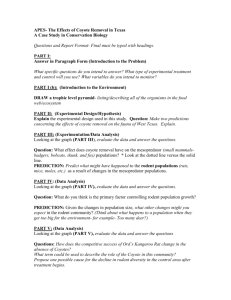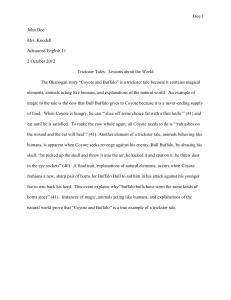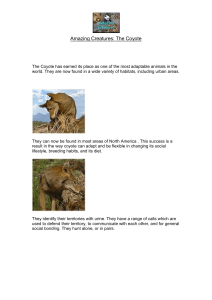Intermediate Junior English: Native American Creation Myths Cherokee
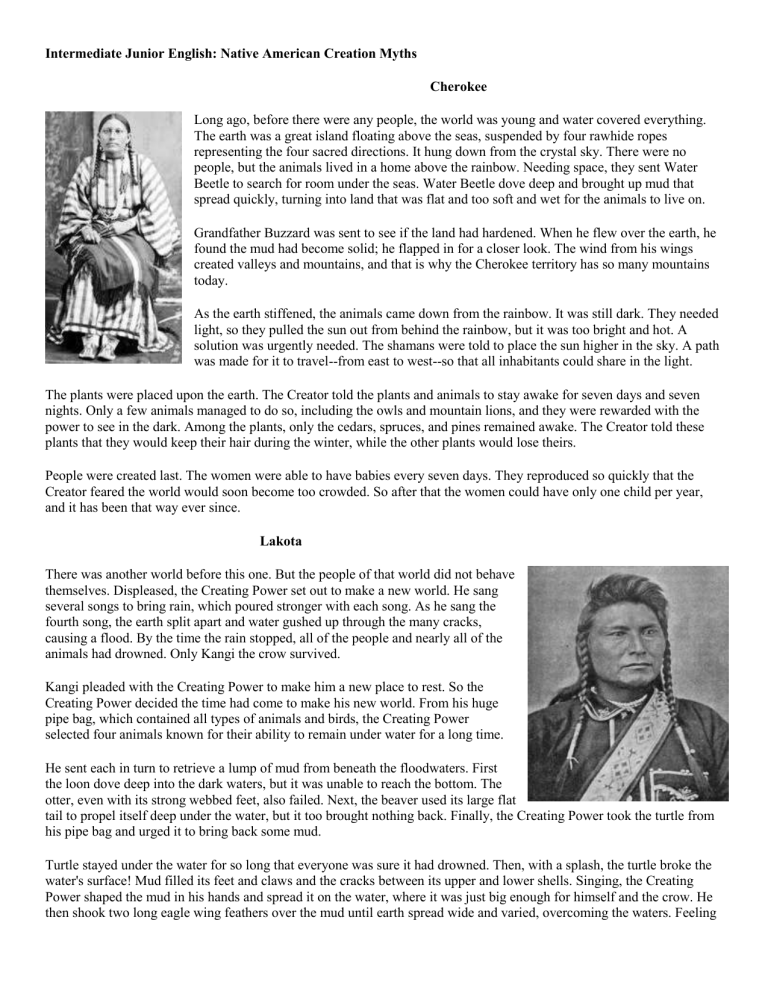
Intermediate Junior English: Native American Creation Myths
Cherokee
Long ago, before there were any people, the world was young and water covered everything.
The earth was a great island floating above the seas, suspended by four rawhide ropes representing the four sacred directions. It hung down from the crystal sky. There were no people, but the animals lived in a home above the rainbow. Needing space, they sent Water
Beetle to search for room under the seas. Water Beetle dove deep and brought up mud that spread quickly, turning into land that was flat and too soft and wet for the animals to live on.
Grandfather Buzzard was sent to see if the land had hardened. When he flew over the earth, he found the mud had become solid; he flapped in for a closer look. The wind from his wings created valleys and mountains, and that is why the Cherokee territory has so many mountains today.
As the earth stiffened, the animals came down from the rainbow. It was still dark. They needed light, so they pulled the sun out from behind the rainbow, but it was too bright and hot. A solution was urgently needed. The shamans were told to place the sun higher in the sky. A path was made for it to travel--from east to west--so that all inhabitants could share in the light.
The plants were placed upon the earth. The Creator told the plants and animals to stay awake for seven days and seven nights. Only a few animals managed to do so, including the owls and mountain lions, and they were rewarded with the power to see in the dark. Among the plants, only the cedars, spruces, and pines remained awake. The Creator told these plants that they would keep their hair during the winter, while the other plants would lose theirs.
People were created last. The women were able to have babies every seven days. They reproduced so quickly that the
Creator feared the world would soon become too crowded. So after that the women could have only one child per year, and it has been that way ever since.
Lakota
There was another world before this one. But the people of that world did not behave themselves. Displeased, the Creating Power set out to make a new world. He sang several songs to bring rain, which poured stronger with each song. As he sang the fourth song, the earth split apart and water gushed up through the many cracks, causing a flood. By the time the rain stopped, all of the people and nearly all of the animals had drowned. Only Kangi the crow survived.
Kangi pleaded with the Creating Power to make him a new place to rest. So the
Creating Power decided the time had come to make his new world. From his huge pipe bag, which contained all types of animals and birds, the Creating Power selected four animals known for their ability to remain under water for a long time.
He sent each in turn to retrieve a lump of mud from beneath the floodwaters. First the loon dove deep into the dark waters, but it was unable to reach the bottom. The otter, even with its strong webbed feet, also failed. Next, the beaver used its large flat tail to propel itself deep under the water, but it too brought nothing back. Finally, the Creating Power took the turtle from his pipe bag and urged it to bring back some mud.
Turtle stayed under the water for so long that everyone was sure it had drowned. Then, with a splash, the turtle broke the water's surface! Mud filled its feet and claws and the cracks between its upper and lower shells. Singing, the Creating
Power shaped the mud in his hands and spread it on the water, where it was just big enough for himself and the crow. He then shook two long eagle wing feathers over the mud until earth spread wide and varied, overcoming the waters. Feeling
sadness for the dry land, the Creating Power cried tears that became oceans, streams, and lakes. He named the new land
Turtle Continent in honor of the turtle who provided the mud from which it was formed.
The Creating Power then took many animals and birds from his great pipe bag and spread them across the Earth. From red, white, black, and yellow earth, he made men and women. The Creating Power gave the people his sacred pipe and told them to live by it. He warned them about the fate of the people who came before them. He promised all would be well if all living things learned to live in harmony. But the world would be destroyed again if they made it bad and ugly.
Potawatomi
Anishnabe found himself alone on earth. The Creator told him to give everything a name, and he did this, accompanied by a wolf. He discovered that only he, among the many species, was alone, without a mate, and he was lonely.
He traveled to the Great Lakes and while searching, heard a beautiful song coming across the water. The woman's voice was singing that she was making a home for him.
He fell in love with the voice and the song. In the days that followed, he learned how to cross the water and finally came to a lodge facing west. There lived a beautiful woman and her father, the Firekeeper.
This was the first union - Anishabe and the Firekeeper's Daughter. It determined the roles of men and women in marriage. They had four sons, who when they were grown traveled to the four directions of the earth. The son who traveled north had a hard journey, but learned that the melting snow cleansed Mother Earth. Because of the snow, the color for North is white. This son married the daughter of the Spirit of the North and was given sweetgrass, the first gift of Mother Earth. It is kept in a braid like a mother's hair.
The second son traveled east, into the yellow of the rising sun. He learned that fire is the essence of life and gained in knowledge of the Creator. He married the daughter of the Spirit of the East, and was given tobacco to use in prayer, to communicate with the Creator.
The third son went south, which is the woman's direction from which comes seeds and other things that give life. Red, the color of life's blood, is the the color for south. He married the Spirit of the South's daughter and was given the gift of cedar, which is used to cleanse and purify the home and prepare for food.
The fourth son went West, toward the mountains. Marrying the Spirit of the West's daughter, he was given sage and learned that the setting sun represents the circle of life and its cycle. The color for West is black, for the dark time, and the sage, a strong purifier, is to keep illness away.
Smoke from the cedar and sage is fanned upward with an eagle feather because the eagle once saved the Indian people when the Creator would have destroyed them. The eagle told the Creator there were faithful people on earth, and was sent out each morning to see if the smoke still rose from the lodges of those good people. Fanning the smoke with the eagle feather symbolizes the eagle delivering the message to the Creator that his people are still there and still believe.
Trickster Tales are present in oral traditions WORLD WIDE, and have some of the following elements in common…
They can be told for amusement as well as on serious or sacred occasions.
North American trickster motifs generally combine moral lessons with humor.
These stories typically celebrate the resourcefulness and imagination of the trickster.
The Trickster…
The protagonist (often an animal, a.k.a. “the trickster”) has magical powers and is commonly characterized by opposites, such as omniscient creator and innocent fool or malicious destroyer and childlike prankster.
Often the trickster is “going along” and encounters a situation in which he responds with any or all of the following: bravery, stupidity, gluttony, or cunning.
The trickster may meet a ridiculous or even violent end.
The trickster frequently serves as a transformer and a cultural hero who turns order out of chaos.
He often tries to teach humans, but his efforts frequently end in failure.
The trickster may have a companion who serves as either a stooge or a double-crosser, ultimately tricking the trickster.
Intermediate Junior English: American Indian Trickster Tales
Crow Brings the Daylight: An Inuit Myth retold by S. E. Schlosser
Long, long ago, when the world was still new, the Inuit lived in darkness in their home in the fastness of the north. They had never heard of daylight, and when it was first explained to them by Crow, who traveled back and forth between the northlands and the south, they did not believe him.
Yet many of the younger folk were fascinated by the story of the light that gilded the lands to the south. They made Crow repeat his tales until they knew them by heart.
"Imagine how far and how long we could hunt," they told one another.
"Yes, and see the polar bear before it attacks," others agreed.
Soon the yearning for daylight was so strong that the Inuit people begged Crow to bring it to them. Crow shook his head. "I am too old," he told them. "The daylight is very far away.
I can no longer go so far." But the pleadings of the people made him reconsider, and finally he agreed to make the long journey to the south.
Crow flew for many miles through the endless dark of the north. He grew weary many times, and almost turned back. But at last he saw a rim of light at the very edge of horizon and knew that the daylight was close.
Crow strained his wings and flew with all his might. Suddenly, the daylight world burst upon him with all its glory and brilliance. The endless shades of color and the many shapes and forms surrounding him made Crow stare and stare. He flapped down to a tree and rested himself, exhausted by his long journey. Above him, the sky was an endless blue, the clouds fluffy and white. Crow could not get enough of the wonderful scene.
Eventually Crow lowered his gaze and realized that he was near a village that lay beside a wide river. As he watched, a beautiful girl came to the river near the tree in which he perched. She dipped a large bucket into the icy waters of the river and then turned to make her way back to the village. Crow turned himself into a tiny speck of dust and drifted down towards the girl as she passed beneath his tree. He settled into her fur cloak and watched carefully as she returned to the snow lodge of her father, who was the chief of the village people.
It was warm and cozy inside the lodge. Crow looked around him and spotted a box that glowed around the edges. Daylight, he thought.
On the floor, a little boy was playing contentedly. The speck of dust that was Crow drifted away from the girl and floated into the ear of the little boy. Immediately the child sat up and rubbed at his ear, which was irritated by the strange speck. He started to cry, and the chief, who was a doting grandfather, came running into the snow lodge to see what was wrong.
"Why are you crying?" the chief asked, kneeling beside the child.
Inside the little boy's ear, Crow whispered: "You want to play with a ball of daylight." The little boy rubbed at his ear and then repeated
Crow's words.
The chief sent his daughter to the glowing box in the corner. She brought it to her father, who removed a glowing ball, tied it with a string, and gave it to the little boy. He rubbed his ear thoughtfully before taking the ball. It was full of light and shadow, color and form.
The child laughed happily, tugging at the string and watching the ball bounce.
Then Crow scratched the inside of his ear again and the little boy gasped and cried.
"Don't cry, little one," said the doting grandfather anxiously. "Tell me what is wrong."
Inside the boy's ear, Crow whispered: "You want to go outside to play." The boy rubbed at his ear and then repeated Crow's words to his grandfather. Immediately, the chief lifted up the small child and carried him outside, followed by his worried mother.
As soon as they were free of the snow lodge, Crow swooped out of the child's ear and resumed his natural form. He dove toward the little boy's hand and grabbed the string from him. Then he rose up and up into the endless blue sky, the ball of daylight sailing along behind him.
In the far north, the Inuit saw a spark of light coming toward them through the darkness. It grew brighter and brighter, until they could see Crow flapping his wings as he flew toward them. The people gasped and pointed and called in delight.
The Crow dropped the ball, and it shattered upon the ground, releasing the daylight so that it exploded up and out, illuminating every dark place and chasing away every shadow. The sky grew bright and turned blue. The dark mountains took on color and light and form.
The snow and ice sparkled so brightly that the Inuit had to shade their eyes.
The people laughed and cried and exclaimed over their good fortune. But Crow told them that the daylight would not last forever. He had only obtained one ball of daylight from the people of the south, and it would need to rest for six months every year to regain its strength. During that six month period, the darkness would return.
The people said: "Half a year of daylight is enough. Before you brought the daylight, we lived our whole life in darkness!" Then they thanked Crow over and over again.
To this day, the Inuit live for half a year in darkness and half a year in daylight. And they are always kind to Crow, for it was he who brought them the light.
The Great Spirit Names the Animal People:
How Coyote Came by his Powers (Okanogan) from Mourning Dove (Hum-isha-ma; Christal Quintasket), Coyote Tales (1933).
The Great Spirit called all his people together from all over the earth. There was to be a change. He would give names to the people, and the Animal World was to rule. The naming was to begin at the break of day, each one having the right to choose his or her name according to who came first to the Spirit Chief's lodge. The Spirit Chief would also give each one their duty to perform in the changed conditions.
It was the night before the New World. Excitement was among the people. Each one desired a great name of note. All wished to be awake and first at the lodge of the Great Spirit Chief. Everyone wanted power to rule some tribe, some kingdom of the Animal World.
Coyote was of a degraded nature, a vulgar type of life. He was an imitator of everything that he saw or heard. When he asked a question, when he asked for information and it was given him, he would always say, "I knew that before! I did not have to be told." That was
Coyote's way. He was hated by all the people for his ways. No one liked him. He boasted too much about his wisdom, about everything.
Coyote went among the anxious people, bragging to everyone how early he was going to rise, how he would be the first one at the Spirit
Chief's lodge. He bragged of the great name he would choose. He said, "I will have three big names to select from: there is Grizzly Bear, who will be ruler over all running, four-footed animals; Eagle, who will lead all the flying birds; Salmon, who will be chief over all the fish of every kind."
Coyote's twin brother, who took the name of Fox, said to him, "Do not be too sure. Maybe no one will be given his choice of names.
Maybe you will have to retain your own name, Coyote. Because it is a degraded name, no one among the tribes will want to take it.
Coyote went to his tepee in anger. He determined not to sleep that night. He would remain awake so as to be the first at the Spirit
Chief's lodge for the name he wanted. . . . Coyote's wife (afterwards Mole), sat on her feet at the side of the doorway. She looked up at
Coyote and said in a disappointed tone, "Have you no food for the children? They are starving! I can find no roots to dig."
"Eh-ha!" grunted Coyote sarcastically. He answered his wife, "I am no common person to be spoken to in that fashion by a mere woman.
Do you know that I am going to be a great Chief at daybreak tomorrow? I shall be Grizzly Bear. I will devour my enemies with ease. I will take other men's wives. I will need you no longer. You are growing too old, too ugly to be the wife of a great warrior, of a big Chief as I will be."
Coyote ordered his wife to gather plenty of wood for the tepee fire where he would sit without sleep all night. Half of the night passed;
Coyote grew sleepy. His eyes would close however hard he tried to keep them open. Then he thought what to do. He took two small sticks and braced his eyelids apart. He must not sleep! But before Coyote knew it, he was fast asleep. He was awakened by his wife,
Mole, when she returned from the Spirit Chief's lodge, when the sun was high in the morning sky. . . .
Coyote jumped up from where he lay. He hurried to the lodge of the Chief Spirit. Nobody was there, and Coyote thought that he was first. . . . He went into the lodge and spoke, "I am going to be Grizzly Bear!"
The Chief answered, "Grizzly Bear was taken at daybreak!"
Coyote said, "Then I shall be called Eagle!"
The Chief answered Coyote, "Eagle has chosen his name. He flew away long ago."
Coyote then said, "I think that I will be called Salmon."
The Spirit Chief informed Coyote, "Salmon has also been taken. All the names have been used except your own: Coyote. No one wished to steal your name from you."
Poor Coyote's knees grew weak. He sank down by the fire in that great tepee. The heart of the Spirit Chief was touched when he saw the lowered head of Coyote, the mischief-maker. After a silence the Chief spoke, "You are Coyote! You are the hated among all the tribes, among all the people. I have chosen you from among all others to make you sleep, to go to the land of the dream visions. I make a purpose for you, a big work for you to do before another change comes to the people. You are to be father for all the tribes, for all the new kind of people who are to come. Because you are so hated, degraded and despised, you will be known as the Trick-person. You will have power to change yourself into anything, any object you wish when in danger or distress. There are man-eating monsters on the earth who are destroying the people. The tribes cannot increase and grow as I wish. These monsters must all be vanquished before the new people come. This is your work to do. I give you powers to kill these monsters. I have given your twin brother, Fox, power to help you, to restore you to life should you be killed. Your bones may be scattered; but if there is one hair left on your body, Fox can bring you back to life. Now go, despised Coyote! Begin the work laid out for your trail. Do good for the benefit of your people."
Thus, Coyote of the Animal People was sent about the earth to fight and destroy the people-devouring monsters, to prepare the land for the coming of the new people, the Indians. Coyote' eyes grew slant from the effects of the sticks with which he braced them open that night when waiting for the dawn of the name giving day. From this, the Indians have inherited their slightly slant eyes as descendants from Coyote.
How Coyote Stole Fire (Cherokee?)
Long ago, when man was newly come into the world, there were days when he was the happiest creature of all. Those were the days when spring brushed across the willow tails, or when his children ripened with the blueberries in the sun of summer, or when the goldenrod bloomed in the autumn haze.
But always the mists of autumn evenings grew more chill, and the sun's strokes grew shorter. Then man saw winter moving near, and he became fearful and unhappy. He was afraid for his children, and for the grandfathers and grandmothers who carried in their heads the sacred tales of the tribe. Many of these, young and old, would die in the long, ice-bitter months of winter.
Coyote, like the rest of the People, had no need for fire. So he seldom concerned himself with it, until one spring day when he was passing a human village. There the women were singing a song of mourning for the babies and the old ones who had died in the winter.
Their voices moaned like the west wind through a buffalo skull, prickling the hairs on Coyote's neck.
"Feel how the sun is now warm on our backs," one of the men was saying. "Feel how it warms the earth and makes these stones hot to the touch. If only we could have had a small piece of the sun in our teepees during the winter."
Coyote, overhearing this, felt sorry for the men and women. He also felt that there was something he could do to help them. He knew of a faraway mountain-top where the three Fire Beings lived. These Beings kept fire to themselves, guarding it carefully for fear that man might somehow acquire it and become as strong as they. Coyote saw that he could do a good turn for man at the expense of these selfish
Fire Beings.
So Coyote went to the mountain of the Fire Beings and crept to its top. He watched the way that the Beings guarded their fire. As he approached, the Beings leaped to their feet and gazed searchingly round their camp. Their eyes glinted like bloodstones, and their hands were clawed like the talons of the great black vulture.
"What's that? What's that I hear?" hissed one of the Beings.
"A thief, skulking in the bushes!" screeched another.
The third looked more closely, and saw Coyote. But he had gone to the mountain-top on all fours, so the Being thought she saw only an ordinary coyote slinking among the trees.
"It is no one, it is nothing!" she cried, and the other two looked where she pointed and also saw only a grey coyote. They sat down again by their fire and paid Coyote no more attention.
So he watched all day and night as the Fire Beings guarded their fire. He saw how they fed it pine cones and dry branches from the sycamore trees. He saw how they stamped furiously on runaway rivulets of flame that sometimes nibbled outwards on edges of dry grass. He saw also how, at night, the Beings took turns to sit by the fire. Two would sleep while one was on guard; and at certain times the Being by the fire would get up and go into their teepee, and another would come out to sit by the fire.
Coyote saw that the Beings were always jealously watchful of their fire except during one part of the day. That was in the earliest
morning, when the first winds of dawn arose on the mountains. Then the Being by the fire would hurry, shivering, into the teepee calling, "Sister, sister, go out and watch the fire." But the next Being would always be slow to go out for her turn, her head spinning with sleep and the thin dreams of dawn.
Coyote, seeing all this, went down the mountain and spoke to his friends among the People. He told them of hairless man, fearing the cold and death of winter. And he told them of the Fire Beings, and the warmth and brightness of the flame. They all agreed that man should have fire, and they all promised to help Coyote's undertaking.
Then Coyote sped again to the mountain top. Again the Fire Beings leaped up when he came close, and one cried out, "What's that? A thief, a thief!"
But again the others looked closely, and saw only a grey coyote hunting among the bushes. So they sat down again and paid him no more attention.
Coyote waited through the day, and watched as night fell and two of the Beings went off to the teepee to sleep. He watched as they changed over at certain times all the night long, until at last the dawn winds rose.
Then the Being on guard called, "Sister, sister, get up and watch the fire."
And the Being whose turn it was climbed slow and sleepy from her bed, saying, "Yes, yes, I am coming. Do not shout so."
But before she could come out of the teepee, Coyote lunged from the bushes, snatched up a glowing portion of fire, and sprang away down the mountainside.
Screaming, the Fire Beings flew after him. Swift as Coyote ran, they caught up with him, and one of them reached out a clutching hand.
Her fingers touched only the tip of the tail, but the touch was enough to turn the hairs white, and coyote tail tips are white still. Coyote shouted, and flung the fire away from him. But the others of the People had gathered at the mountain's foot. Squirrel saw the fire falling, and caught it, putting it on her back and fleeing away through the treetops. The fire scorched her back so painfully that her tail curled up and back, as squirrels' tails still do today.
The Fire Beings then pursued Squirrel, who threw the fire to Chipmunk. Chattering with fear, Chipmunk stood still as if rooted until the
Beings were almost upon her. Then, as she turned to run, one Being clawed at her, tearing down the length of her back and leaving three stripes that are to be seen on chipmunks' backs even today. Chipmunk threw the fire to Frog, and the Beings turned towards him. One of the Beings grasped his tail, but Frog gave a mighty leap and tore himself free, leaving his tail behind in the Being's hand, which is why frogs have had no tails ever since.
As the Beings came after him again, Frog flung the fire on to Wood. And Wood swallowed it.
The Fire Beings gathered round, but they did not know how to get the fire out of Wood. They promised it gifts, sang to it and shouted at it. They twisted it and struck it and tore it with their knives. But Wood did not give up the fire. In the end, defeated, the Beings went back to their mountaintop and left the People alone.
But Coyote knew how to get fire out of Wood. And he went to the village of men and showed them how. He showed them the trick of rubbing two dry sticks together, and the trick of spinning a sharpened stick in a hole made in another piece of wood. So man was from then on warm and safe through the killing cold of winter.

